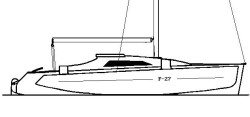Trimaran, Farriar
27' x 19' x 1.3 Tons
12-Ft. Dia. Sea Anchor
Force 8 Conditions
File S/T-21, obtained from Steven C. Wann, Williamsburg, VA. - Vessel name Dancer, hailing port Williamsburg, trailerable trimaran designed by Ian Farriar, LOA 27' x Beam 19' x Draft 5' (14" board up) x 1.3 Tons - Sea anchor: 12-ft. Diameter Para-Tech on 300' x 9/16" nylon three strand rode and 1/2" galvanized swivel - No bridle - Partial trip-line - Deployed in a gale in deep water about 200 miles SSW of Block Island, RI, with winds of 40 knots and seas of 8-10 ft. - Vessel's bow yawed 30° - Drift was estimated to be about 2 n.m. during 10 hours at sea anchor.
The F-27 trimaran is trailerable, fast and seaworthy. Steven Wann used a para-anchor on his in a gale seventy miles off the New Jersey coast. Transcript:
I feel that I should mention that I have made one Pacific and four Atlantic crossings. While all of my ocean crossing have been in monohulls, I have made a few ocean passages in multihulls and expect that I will be doing more multihull ocean sailing in the future. I am aware of the differences between monos and multis, especially in regards to what I call "offshore tactics." For example, I have found that lightweight trimarans like the Corsair series do not go well to windward with waves coming from windward. As Sheldon Bacon mentions in his chapter entitled "Wind Waves" in the latest edition of Coles's Heavy Weather Sailing, seas take some time to build, and the "sea state" often lags behind the "wind state." Thus skippers of multis sailing offshore have to be aware that even though the wind might remain constant in strength and direction over a period of time, the ability of some mutihulls to continue to windward can diminish if the seas build.
In the case of my DDDB form for 19 July '97, it should be noted that the waves were not commensurate in size with the wind force: they were smaller. However, I deployed the sea anchor because
1) the wind and waves were from my destination,
2) I was single-handed and tired,
3) I was in no hurry, and
4) there was sufficient traffic in the area to make me feel that maintaining way and a good lookout would be impossible.
I would like to point out that I was not in any danger, I did not need assistance. In other words, I used the sea anchor not as an emergency device, but as part of my "normal" offshore tactics. I feel this is an important point.
In the case of my DDDB form for 16 August '97, I felt I was in an unsustainable situation: I had considerable gear failure (instrumentation, bowsprit and autopilot mounting, to mention a few), the wind and seas were from my destination and building, the weather forecast was for more of the same for the next two days, and I was exhausted. Thus I felt that I was unable to continue under those situations.
I would add that there are at least three situations in which I would use a sea anchor:
1) "I don't want to continue under the current weather conditions."
2) "I can't continue, but I don't need assistance."
3) "I can't continue and will need assistance when the present weather conditions moderate."
For the second deployment I had removed the trip line and float. I saw no advantage in their use during the first deployment and was concerned that the trip line could foul the chute in some way. Regarding bridles, I felt that Corsair's eyes near the bows of the outer amas were inadequate for the load that might be placed on them, were I to use a bridle. As I see it, the only advantage of a bridle on a multihull is to stop the boat from yawing, and in my case I did not see the yawing to be a problem. The yawing, which I felt was considerable, was in no way apparent belowdecks, and in any case is something that most multihull sailors have probably become accustomed to at ground anchor.
On deployment the first time, I was surprised how easy the movement of Dancer became instantly, and how things quieted down. It was a "time out." This was repeated on the second deployment.
I was also surprised at how much stretch there was in the rode, and how difficult it was to retrieve the rode and the sea anchor. The effort was much greater than just hauling in on a ground anchor rode, for at the time there was still considerable wind and sea. Even though the F-27 only displaces 2600 pounds, considerable effort was required to winch in the rode and sea anchor, and in the time it took to do so I worked up a good sweat. I had run the rode from the port fairlead to starboard of the bow cleat and back along the deck to the port winch, just forward of the cockpit. I would recommend this lead to other F-27 owners. There was so much strain on the rode that it would stretch six inches just from the bow to the winch!
Another surprise was that the sea anchor [without float] took a position not near the surface of the water, but down maybe 30° from parallel to the surface of the water. While I didn't have any chain on the rode, the weight of the sea anchor, fitting, swivel and line were enough to sink the setup considerably, possibly because of relatively light wind conditions [at retrieval time]. On retrieval, I learned to watch the bow drop into a trough and then winch like mad!
